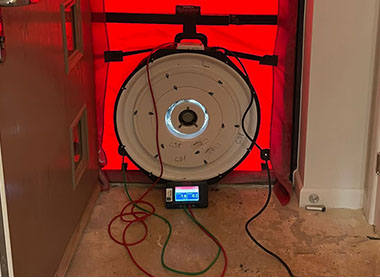
Air Tightness Testing
What is Air Tightness Testing? Air Tightness Testing (also known as Air Permeability Testing; Air Leakage Testing and Air Pressure testing) is performed to determine the movement of air through the thermal envelope surrounding a building. As per Part L of building regulations sections 1A and 1B, all new builds both domestic and non-domestic require Air tightness testing.
This process is undertaken by installing blower door testing kit to an external opening and attaching a large fan linked to an anemometer. Using the fan, the building is then pressurised or depressurised (depending on preferred technique) to create a pressure difference across the buildings thermal envelope ranging from 0-50Pa. The anemometer then records the external pressure, internal pressure, and output of the fan to maintain said pressure difference and from this, an air permeability figure is calculated and given in units of m3 . m-1 . m-2@ 50Pa.
Air tightness certificates are a sure way of quantifying a buildings capability to separate the cold external air from the comfortable internal air we all enjoy living in. the lower the air permeability of a building, the less heat energy is wasted from air leakage through the thermal envelope. Resulting in lower cost and carbon footprint associated with heating a building, saving the occupant money on their energy bills and minimising the effect on the environment. Air leakage through a poor-quality thermal envelope has been shown to account for up to 50% of heat losses from a building.
When is the best time to carry out an Air Tightness Test?
Before an air tightness test can be performed, it’s essential for your dwelling to be fully built and sealed. Additionally, you will need your SAP score as this will set a target for the air test.
Here at CDP we have ATTMA registered air testers along with sustainability consultants who provide a comprehensive service covering all aspects of Part L building requirements and support you through the whole process. Additionally, we offer pre-tests as early along in the construction process as possible to identify any potential issues before it becomes a costly mistake. Please see summary of the process below.
Our process
Before the air tightness test:
• Office based technical advice for air
tightness testing and all energy related
activities such as SAP and SBEM
• A thorough inspection of units will take
place before air tightness tests to
highlight any potential problems prior
to testing
During the air test:
• Calculate the building footprint,
thermal envelope area and number
of external openings
• Optional pre-tests in the early stages
of construction before plastering and
2nd fix of services
• Final air tightness test to take place upon
completed construction of the building,
generating final air permeability results
and providing certification within 5 days
of the testing day






© Copyright 2023 Carpenter Davies Partnership Ltd.
All rights reserved.



